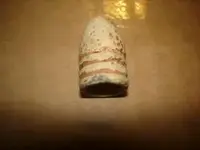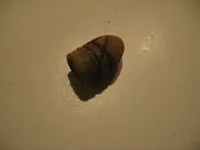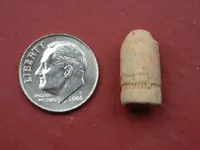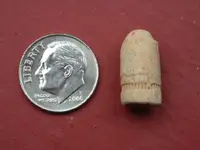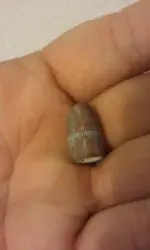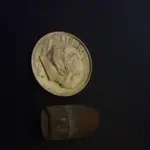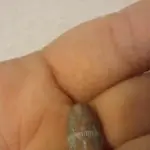You are using an out of date browser. It may not display this or other websites correctly.
You should upgrade or use an alternative browser.
You should upgrade or use an alternative browser.
Bullet question
- Thread starter DIGGING1971GUY
- Start date
duggap
Bronze Member
- Joined
- Dec 11, 2007
- Messages
- 2,055
- Reaction score
- 1,053
- Golden Thread
- 0
- Location
- Chattanooga, TN
- Detector(s) used
- Tosoro Bandido
- Primary Interest:
- Metal Detecting
What you have is the civilwar era Minie ball. A three ring bullet in .377 cal.
Upvote
0
DIGGING1971GUY
Sr. Member
- #3
Thread Owner
Thanks, about what year did they use these ?duggap said:What you have is the civilwar era Minie ball. A three ring bullet in .377 cal.
I found this one only an inch in the ground if that
Upvote
0
Breezie
Gold Member
- Joined
- Oct 3, 2009
- Messages
- 6,269
- Reaction score
- 2,119
- Golden Thread
- 1
- Location
- North Carolina
- 🥇 Banner finds
- 1
- Detector(s) used
- White's DFX & Spectrum~Garrett's Pro-Pointer~VibraProbe
- Primary Interest:
- Metal Detecting
DiggingGuy, You need to go back to the area where you found this 3-ring Minie; there should be MORE Civil War relics there. Nice find  Breezie
Breezie
Upvote
0
DIGGING1971GUY
Sr. Member
- #5
Thread Owner
Yep,it is my 2nd one from this new location it is a huge park though over a mile long and wideBreezie said:DiggingGuy, You need to go back to the area where you found this 3-ring Minie; there should be MORE Civil War relics there. Nice findBreezie
It has a lake ,odd thing is the park was built in 1952 so i was very excited to find a 1920 merc and the two three ringers.
Upvote
0
TheCannonballGuy
Gold Member
- Joined
- Feb 24, 2006
- Messages
- 6,607
- Reaction score
- 13,455
- Golden Thread
- 0
- Location
- Occupied CSA (Richmond VA)
- Detector(s) used
- White's 6000, Nautilus DMC-1, Minelab
- Primary Interest:
- Relic Hunting
Duggap, I think you meant to say .577, not .377 caliber. ;-)
Digging1971guy, your civil war era bullet is an American version of the bullet invented by a French Army captain named Minie ...hence the name for it is "Minie" bullet. The US version was developed in experiments by the Army in the mid-to-late 1850s, finally settling on a design with a conical cavity in the bullet's base and three grooves on the bullet's cylindrical sides. Hundreds of millions of them were manufactured for the US Army between 1861 and 1865. Therefore, the US .577/.58-caliber 3-groove Minie bullet is the #1-most-common of all the varieties of civil war bullets. But the "Minie" bullet very rapidly fell out of favor immediately after the war ended, due to the advent of breechloading repeating rifles, which used a bullet in a metal caratridge casing. (For example, the Model-1866 Winchester Repeater.) So, "the statistical odds" enormously favor your US 3-groove Minie having been manufactured sometime between 1861 and 1865.
Digging1971guy, your civil war era bullet is an American version of the bullet invented by a French Army captain named Minie ...hence the name for it is "Minie" bullet. The US version was developed in experiments by the Army in the mid-to-late 1850s, finally settling on a design with a conical cavity in the bullet's base and three grooves on the bullet's cylindrical sides. Hundreds of millions of them were manufactured for the US Army between 1861 and 1865. Therefore, the US .577/.58-caliber 3-groove Minie bullet is the #1-most-common of all the varieties of civil war bullets. But the "Minie" bullet very rapidly fell out of favor immediately after the war ended, due to the advent of breechloading repeating rifles, which used a bullet in a metal caratridge casing. (For example, the Model-1866 Winchester Repeater.) So, "the statistical odds" enormously favor your US 3-groove Minie having been manufactured sometime between 1861 and 1865.
Upvote
0
DIGGING1971GUY
Sr. Member
- #7
Thread Owner
Thanks ,great info !! I hope there is more from that era in this place !!TheCannonballGuy said:Duggap, I think you meant to say .577, not .377 caliber. ;-)
Digging1971guy, your civil war era bullet is an American version of the bullet invented by a French Army captain named Minie ...hence the name for it is "Minie" bullet. The US version was developed in experiments by the Army in the mid-to-late 1850s, finally settling on a design with a conical cavity in the bullet's base and three grooves on the bullet's cylindrical sides. Hundreds of millions of them were manufactured for the US Army between 1861 and 1865. Therefore, the US .577/.58-caliber 3-groove Minie bullet is the #1-most-common of all the varieties of civil war bullets. But the "Minie" bullet very rapidly fell out of favor immediately after the war ended, due to the advent of breechloading repeating rifles, which used a bullet in a metal caratridge casing. (For example, the Model-1866 Winchester Repeater.) So, "the statistical odds" enormously favor your US 3-groove Minie having been manufactured sometime between 1861 and 1865.
Upvote
0
duggap
Bronze Member
- Joined
- Dec 11, 2007
- Messages
- 2,055
- Reaction score
- 1,053
- Golden Thread
- 0
- Location
- Chattanooga, TN
- Detector(s) used
- Tosoro Bandido
- Primary Interest:
- Metal Detecting
Yep, thanks, I meant .577. When you get old the fingers don't hit the keys where you want them to and the eyes are too old to catch it. But I agree with Breezie, you need to hit that site some more. If there was a bullet there then there could be a belt plate. Good luck.
Upvote
0
TheCannonballGuy
Gold Member
- Joined
- Feb 24, 2006
- Messages
- 6,607
- Reaction score
- 13,455
- Golden Thread
- 0
- Location
- Occupied CSA (Richmond VA)
- Detector(s) used
- White's 6000, Nautilus DMC-1, Minelab
- Primary Interest:
- Relic Hunting
Speaking of "getting old"... I forgot to mention to Digging1971guy that his civil war bullet is in un-fired condition. We civil war relic-diggers refer to an unfired bullet as a "dropped" bullet. That term has special meaning for civil war relic-hunters, because a fired bullet can travel 500 yards before it falls to earth ...and thus be FAR away from any other civil war relics. But finding a "dropped" bullet means the soldier was standing at the exact spot where that bullet was found, and thus there's a very high probability that other civil war relics are in the ground nearby it. So, we'll hunt that spot extra-diligently, trying not to miss sweeping our detector's searchcoil over even a single square-foot of it.
Upvote
0
DIGGING1971GUY
Sr. Member
- #10
Thread Owner
I was really hoping that ,I spent 7 hours today combing the area and nothing ,that bullet also was less than an inch in the groundTheCannonballGuy said:Speaking of "getting old"... I forgot to mention to Digging1971guy that his civil war bullet is in un-fired condition. We civil war relic-diggers refer to an unfired bullet as a "dropped" bullet. That term has special meaning for civil war relic-hunters, because a fired bullet can travel 500 yards before it falls to earth ...and thus be FAR away from any other civil war relics. But finding a "dropped" bullet means the soldier was standing at the exact spot where that bullet was found, and thus there's a very high probability that other civil war relics are in the ground nearby it. So, we'll hunt that spot extra-diligently, trying not to miss sweeping our detector's searchcoil over even a single square-foot of it.
on a path that people walk daily ,I just cant figure it out ,I also found a fired one in the same park about 4 days before about 50 yards
from the dropped one .
Upvote
0
baylorhall
Hero Member
- Joined
- Nov 17, 2008
- Messages
- 897
- Reaction score
- 154
- Golden Thread
- 0
- Location
- North Texas
- 🏆 Honorable Mentions:
- 1
- Detector(s) used
- Ace 250, AT Pro
- Primary Interest:
- All Treasure Hunting
Upvote
0
High Plains Digger
Bronze Member
Your photo is a little dark, and I am not the total encyclopedia that Cannonballguy is, but if those are 'reeded' lines in the bottom groove, that would date the bullet around 1900, plus or minus a few years. I have had the same high expectations also, and have been educated by some of the best here. And my heart ripped out while I was thrown to the floor in a weaping pile. Well, it felt that way, anyway. Also happened when I found a naval button that looked really old.............................
Upvote
0
baylorhall
Hero Member
- Joined
- Nov 17, 2008
- Messages
- 897
- Reaction score
- 154
- Golden Thread
- 0
- Location
- North Texas
- 🏆 Honorable Mentions:
- 1
- Detector(s) used
- Ace 250, AT Pro
- Primary Interest:
- All Treasure Hunting
That would make more sense to me. Thanks!!
Upvote
0
TheCannonballGuy
Gold Member
- Joined
- Feb 24, 2006
- Messages
- 6,607
- Reaction score
- 13,455
- Golden Thread
- 0
- Location
- Occupied CSA (Richmond VA)
- Detector(s) used
- White's 6000, Nautilus DMC-1, Minelab
- Primary Interest:
- Relic Hunting
High Plains Digger has been doing some very good relic-learning.  I've just got a several-decades headstart, that's all. But he is catching up fast.
I've just got a several-decades headstart, that's all. But he is catching up fast.
Yes, sometimes the Facts about a relic are disappointing ...but I myself do not want to treasure a relic that in truth is not what I think it is. And I'd rather find out the truth about it "early" instead of late.
For anybody here who is not familar with the term "reeded groove" ...it means the groove which encircles the bullet's body has numerous short parallel lines in the groove. Put another way... the bullet's body-groove looks like it was made by pressing the edge of a US dime into the bullet. Here's a photo showing a reeded groove on a bullet.
Reeded grooves bullets seem to start showing up during the US Indian Wars era, at approximately the 1880s. Absolutely no Civil War era bullets had reeded grooves.
Reeded grooves are found more often on pistol ammo than rifle ammo. Reeded-groove bullets were made by more than one bullet-manufacturer, so unfortunately they are not very helpful for identifying a bullet ...but, as mentioned above, they do put a limit on the bullet's age.
 I've just got a several-decades headstart, that's all. But he is catching up fast.
I've just got a several-decades headstart, that's all. But he is catching up fast.Yes, sometimes the Facts about a relic are disappointing ...but I myself do not want to treasure a relic that in truth is not what I think it is. And I'd rather find out the truth about it "early" instead of late.
For anybody here who is not familar with the term "reeded groove" ...it means the groove which encircles the bullet's body has numerous short parallel lines in the groove. Put another way... the bullet's body-groove looks like it was made by pressing the edge of a US dime into the bullet. Here's a photo showing a reeded groove on a bullet.
Reeded grooves bullets seem to start showing up during the US Indian Wars era, at approximately the 1880s. Absolutely no Civil War era bullets had reeded grooves.
Reeded grooves are found more often on pistol ammo than rifle ammo. Reeded-groove bullets were made by more than one bullet-manufacturer, so unfortunately they are not very helpful for identifying a bullet ...but, as mentioned above, they do put a limit on the bullet's age.
Attachments
Upvote
0
DIGGING1971GUY
Sr. Member
- #15
Thread Owner
TheCannonballGuy said:High Plains Digger has been doing some very good relic-learning.I've just got a several-decades headstart, that's all. But he is catching up fast.
Yes, sometimes the Facts about a relic are disappointing ...but I myself do not want to treasure a relic that in truth is not what I think it is. And I'd rather find out the truth about it "early" instead of late.
For anybody here who is not familar with the term "reeded groove" ...it means the groove which encircles the bullet's body has numerous short parallel lines in the groove. Put another way... the bullet's body-groove looks like it was made by pressing the edge of a US dime into the bullet. Here's a photo showing a reeded groove on a bullet.
Reeded grooves bullets seem to start showing up during the US Indian Wars era, at approximately the 1880s. Absolutely no Civil War era bullets had reeded grooves.
Reeded grooves are found more often on pistol ammo than rifle ammo. Reeded-groove bullets were made by more than one bullet-manufacturer, so unfortunately they are not very helpful for identifying a bullet ...but, as mentioned above, they do put a limit on the bullet's age.
Thanks for all the reply's,some great knowledge on this site ,well one thing I know for sure from your picture is that mine
is not reeded ! Thanks !!
Upvote
0
BuckleBoy
Platinum Member
- Joined
- Jun 12, 2006
- Messages
- 18,132
- Reaction score
- 9,701
- Golden Thread
- 4
- Location
- Moonlight and Magnolias
- 🥇 Banner finds
- 4
- 🏆 Honorable Mentions:
- 2
- Detector(s) used
- Fisher F75, Whites DualField PI, Fisher 1266-X and Tesoro Silver uMax
- Primary Interest:
- All Treasure Hunting
I have to ask...you DO know what that is in your avatar photo, don't you?
Upvote
0
Similar threads
- Replies
- 8
- Views
- 293
- Replies
- 3
- Views
- 524
Users who are viewing this thread
Total: 1 (members: 0, guests: 1)
Latest Discussions
-
-
-
-
Confederate Gold from the Civil War was Found in a Shocking Place
- Latest: diamonddave
-

